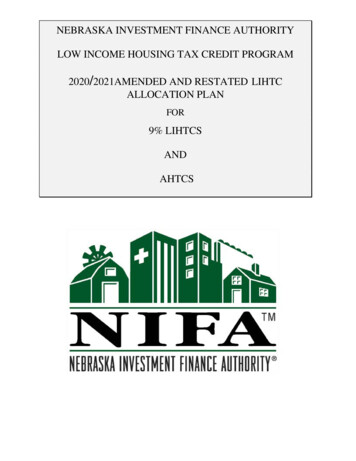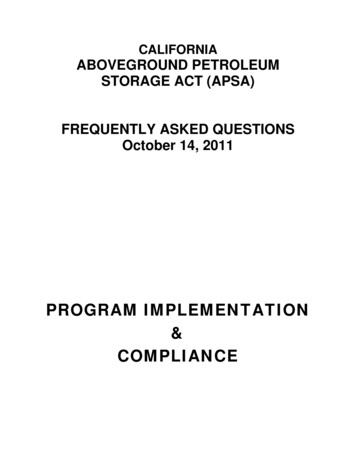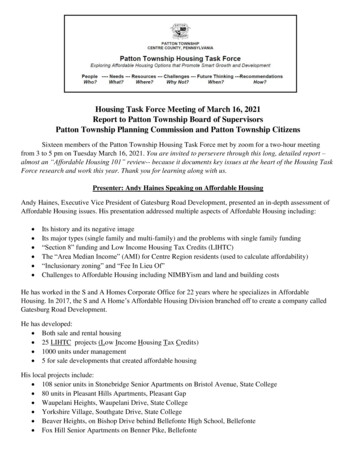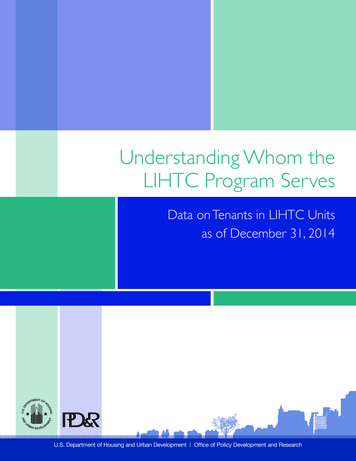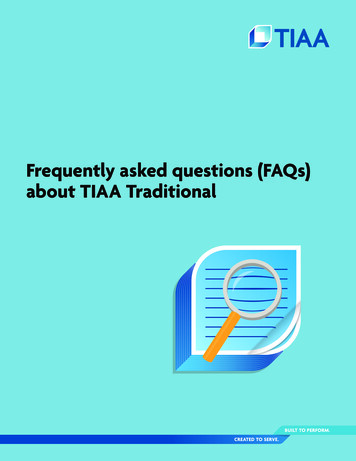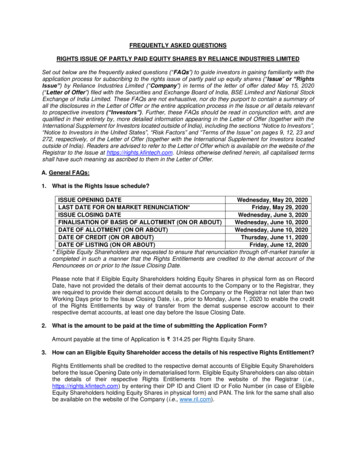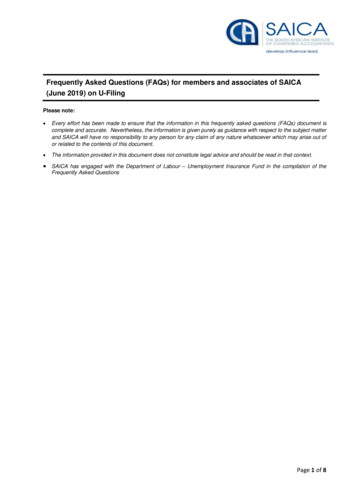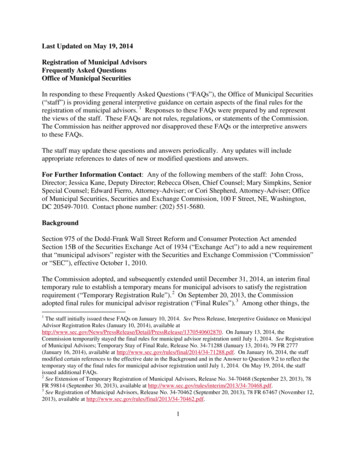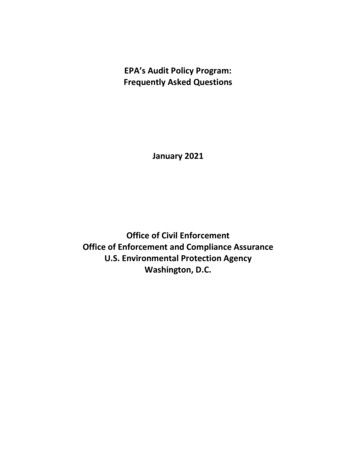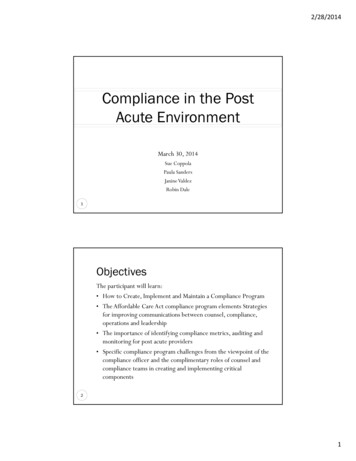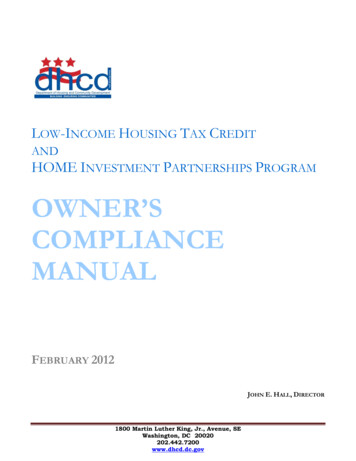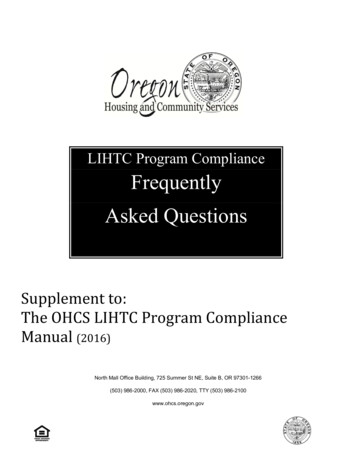
Transcription
LIHTC Program ComplianceFrequentlyAsked QuestionsSupplement to:The OHCS LIHTC Program ComplianceManual (2016)North Mall Office Building, 725 Summer St NE, Suite B, OR 97301-1266(503) 986-2000, FAX (503) 986-2020, TTY (503) 986-2100www.ohcs.oregon.gov
Table of ContentsFAQs Overview: . 1Rent and Income Limits: . 1Fees: . 2Verifications and Documentation: . 4Student Income: . 6Student Status: . 7Eligibility: . 8Screening Practices: . 8Maintaining State Elected Set-Asides: . 9General Over Income: . 9Wait-lists, AFHMPS’s, Advertising, Resident Services and Preferences: . 10Turn Time and Vacancy Time: . 11Certification Signature Timing: . 12Common Area Units Occupied by On-Site Managers, Maintenance Personnel and Security Guards: . 12
FAQs Overview:This Supplemental material is intended to provide additional guidance and answers to questions that arefrequently asked regarding LIHTC program compliance. It was developed pursuant to Section 42 of the Codeand the IRS Procedure for Monitoring Compliance and is intended for use by Owners, Managing Agents, andon-site personnel as well as others involved with OHCS procedures for monitoring compliance with the taxcredit program. It is intended to be used as a supplement to the 2016 OHCS LIHTC Program ComplianceManual. The manual is located on the OHCS website HCS-LIHTC-Compliance-Manual.pdfThis supplement is divided into Topics. The Frequently Asked Questions are preceded with a Q and theAnswers follow immediately and are preceded with an A.Rent and Income Limits:Q: How are income and rent limits calculated for tax credit properties?A: HUD publishes the 50% and 60% limits annually for the tax credit program. Oregon has additional setasides (typically 30% and 40%) and calculates the limits for those set-asides based on the HUD limits.Under the Housing and Economic Recovery Act (HERA) Tax credit properties that placed in serviceprior to 2008 are grandfathered from having their applicable limits go down. If limits in a county godown, pre-2008 properties can use the higher “HERA” limits rather than the current, lower limit.Q: If an existing pre-2008 LIHTC property receives a new allocation of tax credits, is the property eligible touse HERA limits?A: No, the property must use the current Income and Rent limits or the rent limit established per the gross rentfloor.Q: What consequences result from overcharging rent?A: Serious consequences can occur when rent is overcharged in an LIHTC unit. Once a unit is determined to beout of compliance with the rent limits, the unit ceases to be a low-income unit for the remainder of thecalendar year. The potential financial impact for the owner can be substantial. Even though the Owner isrequired by OHCS to refund all over paid rent to the tenant, the unit will still be considered to be in noncompliance until the beginning of the next year.Q: If the rent is over the State set-aside limit but not the Federal set-aside limit, is the unit still reported to theIRS?A: No, however the units will be considered to be out of compliance and OHCS will require the overpaid rent tobe reimbursed. If the Owner/Agent does not provide documentation demonstrating that the rent wasrefunded, the property will be considered to be out of compliance and other consequences of compliancewill apply.1 PageOHCS LIHTC Program Manual – Supplement - June 2017
Q: Can I charge a tenant pet rent?A: No, OHCS does not allow pet rent. A reasonable and refundable pet deposit is allowed. However, therefundable deposit must not be charged to those who have a pet that is considered a service, therapy, orassistance animal.Q: Can I require a tenant to pay a higher rent if they refuse to sign a lease renewal?A: You cannot raise a tenant’s rent based on the fact that they do not want to and/or cannot renew their lease fora specific amount of time. However, you can offer a rent reduction to those who agree to sign a renewalfor a specified amount of time. The key is to think incentive and not penalty. A reasonable rent increasewhen the lease expires is permissible consistent with the local market taking into consideration themaximum rent limit allowed.Q: How much rent can be charged for a unit occupied by a Housing Choice Voucher Holder?A: The total rent charged cannot impact the tenant portion of rent as normally calculated by the public housingauthority (PHA). The Owner or Agent can charge the PHA up to the amount the PHA is willing to pay ifthere is no additional cost added to the tenant’s portion of rent as calculated by their income. SomePHA’s may allow an Owner or Agent to charge more than the payment standard and add the overcharged amount to the tenant’s portion of rent. This is not allowed by OHCS and can make the Owner atrisk of losing tax credits. This may also be perceived as a potential source of discrimination againstvoucher holders.Fees:Q: What fees do I have to include in rent?A: All non-optional fees charged to a tenant must be included in gross rent.Q: Can I charge a non-refundable pet fee or a monthly pet fee?A: No, however a refundable pet security deposit is allowed for non-service animals.Q: Can I charge a fee or rent for a parking space, garage, carport, or storage unit?A: Fees must not be collected for areas that were paid for by the tax credits. In order to charge fees for certainareas of the property, the Owner/Agent must be able to demonstrate that the area was taken out of theeligible basis for the calculation of the tax credit.Q: Can I require renters insurance?A: No, however you can recommend it. If you require it, the cost must be included in gross rent.Q: Can I charge for cable or internet service if we have a contract established and receive a discount with alocal provider?A: Only if the service is optional and there is documentation indicating that the tenant was given an option todecline the service.2 PageOHCS LIHTC Program Manual – Supplement - June 2017
Q: Can I charge a fee for processing an application?A: Yes, however the fee should be limited to the actual out of pocket costs associated with checking aprospective tenant’s income, credit history and landlord references.Q: May I charge month-to-month fee to residents who do not want to execute a new lease (after the initial firstlease expires)?A: No, a month-to-month lease fee is not allowed and a charge such as this would be considered rent and shouldbe included in the units gross rent calculation.Q: Can I charge a resident for excessive utility consumption?A: No, only if the amount charged is included in gross rent.Q: Can I charge non-compliance fees to tenants who have violated their lease agreement?A: Only as allowed per Oregon Landlord Tenant Law.Q: Can I charge a fee for rental of the community room?A: No, not if the room was included in the eligible basis. You can charge a reasonable and affordablerefundable deposit.Q: Can I charge fees to use the swimming pool?A: No, not if the swimming pool was included in the eligible basis.Q: Can I charge a fee or rent for washers and dryers that are located in tenant units?A: It depends. If the eligible basis did not include washers and dryers when the property was funded and thetenants have other options available to them (such as an onsite laundry facility) then there is a possibilitythat washers and dryers can be offered to tenants for a nominal fee/rent. However, the tenant must havethe option of returning the washer/dryers at any time without penalty if they cannot afford the lease/rentfee on the equipment.Q: Can I rent the Community room to an organization for meetings or activities?A: If the Community room was included in the eligible basis, the room cannot be rented to a local organization.It can be offered at no charge to a local organization for periodic meetings or activities, as long as thetenants have the option of attending the meetings or activities held by the organization.Q: Can I charge a cleaning fee to prepare a unit for occupancy before a tenant moves in?A: No, it is not permissible for Owners to charge tenants a fee for maintaining units in a condition suitable foroccupancy.Q: Can I charge a fee if the tenant pays rent late?A: Yes, a reasonable and affordable fee may be collected consistent with Oregon Landlord Tenant law.Q: Can I charge a security deposit?A: All deposits charged must be offered as fully refundable.3 PageOHCS LIHTC Program Manual – Supplement - June 2017
Q: Can I charge a supportive service fee or fees for activities?A: Only if the fees are optional and reasonable.Q: Can I charge fees for assistance with daily living, such as meals, housekeeping, and professional assistance?A: Yes, as long as these fees are entirely optional. Mandatory fees of any kind, including assisted living fees,must be clearly optional or the Owner risks loss of tax credits for the units affected. Marketing materialsand application forms must clearly explain these fees as optional. Written materials should include rulesfor opting in or out of service packages with specific fees for each service detailed and described. Staffshould be trained to explain the options to residents. Documentation should be available to demonstrateclearly that the fees are optional and that the general public can live at the property for the tax credit rentwithout services if they otherwise meet eligibility. The tax credit rents must be advertised.Q: Can I charge a fee for medical alert devices?A: Only if the fee is included in gross rent or documented to be optional.Q: We have a large kitchen and provide meals to residents two times a day. Can I charge for the meals?A: Yes, if the tenants have other options available to them for cooking (such as a fully functional kitchen intheir unit) and the payment for meals is not a required condition of occupancy. The amount charged forthe meals must be reasonable and affordable. The nominal fee should be designed to cover actual costs.Q: Can I charge fees if a tenant pays rent with a credit or debit card?A: Some properties may have a credit/debit card machine onsite (or contract with a third party company toprovide this service) to allow tenants to pay rent using this method. The monthly fee incurred in havinga machine onsite can be passed on to the specific tenants who elect to use this payment method as longas it is an optional fee and charged on a per-usage basis. The fee would be considered optional if thetenants have alternate methods of paying rent that do not include a fee (i.e. cash, check, money order,bank check, etc.). The fee charged to the tenant may not surpass the actual cost incurred from themachine (or third party service provider) and must be disclosed to the tenant prior to processing thetransaction. Management must keep documentation showing the actual costs of providing the serviceand the amount of the fee charged to tenants.Verifications and Documentation:Q: Can I use documentation provided by the applicant or tenant to verify income?A: In most cases no. However, printed statements from state or federal agencies may be used to verify incomeas long as they are current within 120 days of the certification date and provide all of the necessaryinformation. For verification of Social Security benefits, we will accept statements or printouts from theSocial Security office beyond 120 days, if the statement shows the set gross benefit for the current year.Q: Can I use verification from EIV to prove LIHTC income eligibility?A: No, EIV information must not be used to prove eligibility for a tax credit household.4 PageOHCS LIHTC Program Manual – Supplement - June 2017
Q: Can I use pay stubs instead of a Verification of Employment (VOE) form?A: We will only accept pay stubs in lieu of a VOE when three documented attempts to obtain verification over a2 week period fail. Documentation of the attempts must be kept in the file with the pay stubs.Q: Why do I still have to verify information when the tenant questionnaire already asks for the sameinformation?A: The tenant questionnaire is meant to be utilized by the Owner/Agent as a guide for specific information thatneeds to be verified. It is not an actual verification form.Q: When do I utilize the Under 5000 Asset Certification form?A: The Under 5000 Asset Certification form must be completed by all adult household members and kept inevery LIHTC tenant file unless the assets of the household are being third party verified.Q: If an applicant anticipates Social Security Income on their application but benefits have not been awardedyet, do we still have to verify and count the income?A: If the applicant indicates that they have applied or will apply for benefits within the next 12 months we askthat you verify what their award amount will be and count that towards their anticipated gross income.a) The Social Security website offers a page which shows if an applicant is eligible and what themonthly award amount will be. The applicant must create an account at www.ssa.gov in order to accessthe information. Any documentation the resident may have from Social Security can be used as well.b) If getting a benefits statement is difficult, ask the applicant for copies of any correspondence fromSocial Security Administration related to the status of their benefits application. If the applicant hasengaged an attorney to help process their application, obtain a written statement from the attorneyaddressing the status of the application, likelihood of receiving benefits, and an estimate of the benefitamount to be received.Q: How do I verify the specifics of an adult household member who indicates that they have no income fromany source?A: The individual must complete the Income Status Certification form providing details regarding how theywill pay for their rent and living expenses.Q: An applicant does not currently have a job and has no other income. However, he is looking for and expectsto find a job soon. How do I verify their income?A: Generally, current circumstances are used to determine anticipated income. In addition to the Income StatusCertification form the Owner or Agent must calculate and verify all verifiable sources of incomeanticipated in the next 12 months (for example if the applicant indicates they have been offered a joband will start in the future). If the applicant or tenant has verifiable income then it must be verified. Ifthey have unverifiable income (for example they expect to be offered a job but an offer has not come inyet) then there would be nothing to verify or calculate.Q: How do I verify benefits that are loaded on EBT, Reliacards, Emerald Card & Direct Express type debitcards?A: The benefit or money that is loaded on the card itself is considered income and the balance is an asset. Thereis no income from the asset to calculate. The balance on the card is considered an asset and needs to beverified in the same manner as you would verify a savings account. There is no interest. Applicants ortenants who receive their benefits on a card would need to provide an account balance no more than 1205 PageOHCS LIHTC Program Manual – Supplement - June 2017
days old at the time of certification. They can obtain the balance by using an ATM machine andobtaining a balance receipt, or by providing a receipt from a transaction showing what the balance is thatis left on the card.Q: Do I have to calculate minimum wage increases and COLA’s when determining income?A: Yes, all income expected to be received in the 12 months following certification must be accounted for. Thiswould also include raises, bonuses, tips, expected over time and other compensation.Q: Do I have to include Veterans Assistance Aid and Attendance Benefits in household income?A: According to HUD’s RHIIP Listserv Posting #284, any money received by the family that is specifically for,or in reimbursement of, the cost of medical expenses for any family member is excluded from annualincome. Because of this, the owner must verify any amount provided for A&A which is used formedical expenses and exclude the verified amount. Any portion of the benefit not being used formedical expenses must be included as income.Q: Do I have to verify the eligibility and income of a 17 year old household member who will turn 18 beforethe next certification?A: Yes, the 17 year old should complete a tenant questionnaire and all sources of income should be verified andincluded as applicable. Only count the anticipated income of the 17 year old for the months after theywill turn 18. If the parent would rather complete and sign the form for the minor, they are able to do so.Student Income:Q: Do I count all of the income from a fulltime student over 18 when calculating the households’ annualincome?A: If the student is employed but is not the head, co-head or spouse, and is a dependent of the Household, youcount only the first 480 of their wages for the entire 12-month period. Also, count all unearned income(Social Security benefits, TANF, unemployment, etc.) for any students. Verification of fulltime studentstatus is required. For students who are the head, co-head or spouse, count all earned and unearnedincome.Q: Is student financial assistance considered income for purposes of qualifying a household for a tax creditunit? If so, what parts do I count?A: No, unless the tax credit unit or resident is receiving some form of Section 8 rental assistance (Project-BasedSection 8 or Housing Choice Voucher). If the student receives some form of Section 8 rental assistance,you must count as income any amount of assistance that is in excess of the amounts which cover tuitionand any other required fees and charges. If the student is over the age of 23 and has children or thestudent is living with his/her parents who are receiving Section 8, all financial assistance is excludedfrom annual income determinations.For additional information about how to count a student’s financial assistance, see Chapter 5 of HUD’sOccupancy Handbook 4350.3. Also see HUD’s PIH Notice 2015-21, published in December 2015,which provides good examples of how to define “required fees and charges.”6 PageOHCS LIHTC Program Manual – Supplement - June 2017
Student Status:Q: How do I determine if someone is a part-time or fulltime student?A: The educational institution will determine PT or Ft status.Q: If someone attends two schools part-time are they considered a full-time student?A: Yes.Q: An eligible resident moved in and at recertification we found that she returned back to school fulltime. Is shestill considered qualified?A: No, when a unit becomes occupied entirely by full-time students at any time (defined as individuals enrolledfulltime at an educational organization for at least five calendar months during the year), the unitbecomes disqualified unless one of the following exceptions apply:The unit must be occupied by at least one individual who is:1. Enrolled in a job training program receiving assistance under the Workforce Investment Act(formerly JTPA) or other similar program funded by a state or local government agency.2. Receiving benefits under Title IV of the Social Security Act (e.g. TANF).3. A single parent and the single parent is not a dependent of another individual, nor are their childrendependents of another individual except another parent of such children.4. Married and eligible to file a joint return.5. A student that was previously under the care of a state foster care program.Q: Do married students need to actually file a joint tax return to qualify as an exception?A: No. It is only necessary to verify that married students are eligible or entitled to file jointly.Q: Can legally married same-sex couples qualify for the “married, filing jointly” student exception?A: Yes.Q: How do I verify student status of an international student who attends school fulltime but receives zerocredits? Schools generally confirm student status by the number of credit hours taken, so it is possiblethat the college may verify their status as part time. Should I consider these students full time or parttime?A: International Students are almost always considered fulltime Students. This is because their Student Visaspecifically requires these students to attend school fulltime to remain in the United States.Q: How do I verify student status for a person who claims to be exempt under the foster care exception?A: The person who indicates that they were a foster child should be able to provide a written statement onletterhead or some sort of documentation from the state or agency that placed them in the foster caresystem. There is no time limit applicable.Q: Can a single pregnant fulltime student use her unborn child to qualify for the student exemption?A: No, the IRS has made it clear that an unborn child can be counted toward household size when determiningthe income limit; however they have not indicated that an unborn child can qualify a student household.An unborn child would not count as an exception to the Student Rule until the child was born.7 PageOHCS LIHTC Program Manual – Supplement - June 2017
Eligibility:Q: Does the LIHTC program or IRS require tenants to be US Citizens?A: No, the IRS has not indicated that there is a citizenship requirement for the LIHTC program.Q: Does Oregon require LIHTC households to be US citizens?A: No, Oregon does not have a citizenship requirement for the LIHTC program.Q: Can the Company I work for or Owner of the property require citizenship for LIHTC tenants?A: Yes, however it is strongly recommended that all policies regarding this are evaluated by an attorney who isknowledgeable about fair housing regulations.Screening Practices:Q: When screening applicants, what is the maximum income to rent ratio I can require?A: ORS 456.722 indicates that OHCS “shall, when awarding public funds for low-income rental housing, give asubstantial preference to low-income housing providers that do not require applicants for such housingto have net income greater than two times the rent”.Most Owners elect to receive this preference when they apply for funding, and it is important that tenantselection practices abide by the requirement.Q: How do I determine income to rent ratio for an applicant receiving a rent subsidy?A: It is mandatory that you only consider the tenant paid portion of the rent when considering income to rentratio.Q: Can I screen applicants for criminal backgrounds?A: Yes, you can screen applicants for criminal backgrounds. However, it is important to have a clear andconsistent policy regarding selection criteria. On April 4, 2016, the HUD Office of General Counselissued a memo titled “Guidance on Application of Fair Housing Act Standards to the Use of CriminalRecords by Providers of Housing and Real Estate-Related Transactions”. This memo should be takeninto consideration when developing a criminal background screening policy.Q: Can I screen a live in aide?A: You can conduct a criminal background screening; however you may not conduct a credit screening.Q: When we received a credit screening back on an applicant the report indicated that the applicant owns ahome. The applicant said that he does not own the home and his brother just used his credit to purchasethe home. Do we need to do anything?A: Yes, if the home is in the applicants name then technically he owns the home and you must treat it as such.8 PageOHCS LIHTC Program Manual – Supplement - June 2017
Maintaining State Elected Set-Asides:Q: The property I manage has 30%, 40%, 50%, and 60% units. One of the tenants I moved in at 30% AMI isnow at 80% AMI and is still paying a 30% rent. Do I need to do anything?A: Yes, it is very important that the lowest rents are always offered to those who have the lowest incomes. Thisshould be monitored on a continuous basis and rent set-asides should be adjusted and floated as needed.Q: It is obvious that a household at 80% AMI can afford the 60% rent but sometimes it is not so obvious, whatif at recertification the tenant was at 38% AMI?A: A tenant should never be rent burdened. In this case it would be best to keep the tenant at the 30% rent untilthey reach at least the next set-aside level.Q: When floating a lower set-aside, how do I choose the low income household to float the lower set-aside to?A: You can either choose from an in-house waiting list or from the property wait list. It is a good idea toestablish an in-house wait list for those who meet the lower set-aside requirements but are not receivingthem. These tenants are normally struggling to pay rent and would benefit from a rent reduction. Eitherway, it is mandatory that you establish a clear and consistent policy on how you will track andimplement floating set-asides.Q: The tenant I placed in a 30% unit received a housing choice voucher. Do I have to do anything?A: It is always best if the lower set-asides are occupied by tenants who do not receive rental assistance becausetenants who pay full rent out of pocket will benefit from a lower rent more than someone who pays rentbased on their income. In this case you could switch the tenant who has a housing choice voucher to a60% set-aside and offer the 30% rent to someone who is rent burdened.Q: Does the tenant have to move to another unit when I switch the set-aside?A: No, normally the set-aside floats from unit to unit. The tenant does not move.Q: Do I have to recertify the household when I float the set-aside to them?A: If the tenant has not been certified in the last 120 days it is best to certify their income so that you have a trueand accurate picture of their income level and their need for a lower set-aside.Q: Does my lease need special wording to float set-asides?A: Yes, it is important that the lease or an addendum explains the set-aside policy and indicates that rent may beraised if income goes up.General Over Income:Q: The property I manage is 100%@60. A tenant is now at 85% of AMI. Can I raise their rent over the 60%rent limit?A: No, you must not raise rent above the max 60% rent.9 PageOHCS LIHTC Program Manual – Supplement - June 2017
Q: The property I manage is 100%@60. We have several tenants who are now over 140% of AMI. They havelived here for years and there is no indication that they want to move. Can we make them move toanother property so that we can house some of the low income applicants on our wait list?A: No, if a tenant initially qualified for the low income set-aside when they moved in, technically they have aright to live at the property no matter what their income is.Wait-lists, AFHMPS’s, Advertising, Resident Services and Preferences:Q: Do tax credit properties have to use waiting lists?A: Yes, OHCS requires all properties to maintain wait lists.Q: I was told in an inspection report that I had to purge my wait list. Is this really necessary?A: Yes, purging a wait list on a regular basis is very important and can have a direct bearing on unit vacancy tooccupancy timing. The goal is to maintain an active waitlist that can be used at any point in time to fillvacancies.Q: How do I close the wait list if I have too many people waiting?A: If you want to close a wait list you first must be able to demonstrate that the list was recently purged. Afterthat there are several things that must be taken into consideration. Call OHCS for pre-approval andcompliance guidance on how to properly close a wait list.Q: Do tax credit properties have to complete an AFHMP?A: Yes, all OHCS properties should complete an AFHMP and maintain a file documenting proof of advertising.Q: Do I send my tax credit AFHMP to HUD for signature and approval?A: No, not unless the property has other funding that requires a HUD signature. For tax credit only properties,the AFHMP should be provided to OHCS for the property file.Q: When should I update the AFHMP?A: The AFHMP should be updated as needed with a maximum time frame of once every five years.Q: Do I have to provide resident services at my tax credit p
when the lease expires is permissible consistent with the local market taking into consideration the maximum rent limit allowed. Q: How much rent can be charged for a unit occupied by a Housing Choice Voucher Holder? A: The total rent charged cannot impact the tenant portion of rent as normally calculated by the public housing authority (PHA). The Owner or Agent can charge the PHA up to the .
